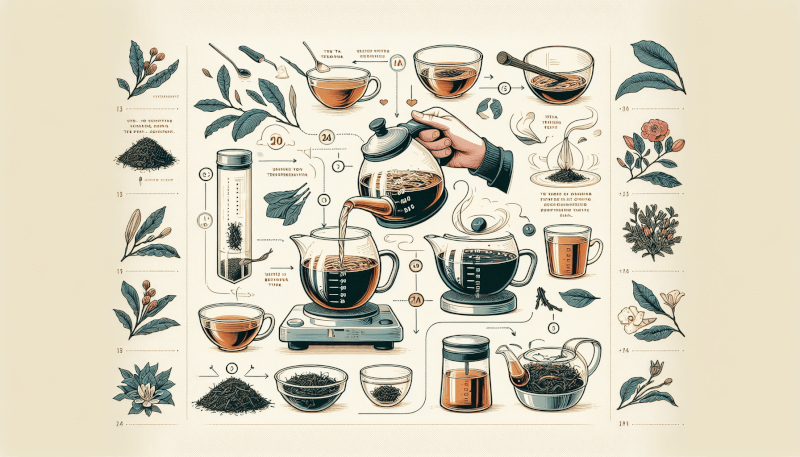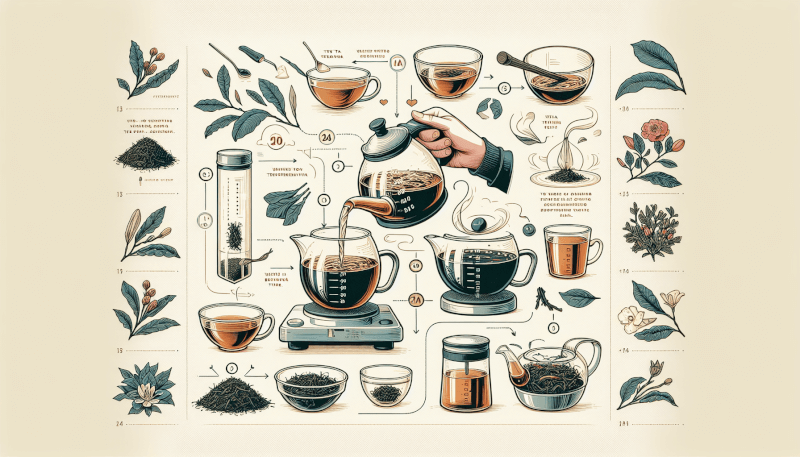Are you a tea lover who is just starting to explore the wonderful world of tea brewing? Look no further, as this article provides the best tea brewing techniques tailored specifically for beginners. Whether you prefer a soothing cup of herbal tea or a robust and flavorful black tea, this comprehensive guide will equip you with the knowledge and skills to brew the perfect cup every time. Say goodbye to guesswork and hello to a delightful tea-drinking experience that will leave you craving for more. Let’s get started!

Choosing the Right Tea
Selecting Tea Varieties
When it comes to choosing the right tea, the first step is to consider the different varieties available. With an extensive range including green, black, white, oolong, and herbal teas, it can be overwhelming to know where to begin. Each type of tea has its own unique characteristics and flavors, so it’s important to explore and experiment with different varieties to find the ones that suit your tastes best. Whether you prefer a bold and robust black tea or a light and delicate green tea, there is a tea out there for everyone.
Considering Tea Grades
Once you have narrowed down the type of tea you prefer, it’s time to consider the different grades available. Tea is often graded based on factors such as leaf size, appearance, and quality. While higher grades may come with a higher price tag, they often offer a more refined and nuanced flavor. However, this doesn’t mean that lower-grade teas should be dismissed. They can still provide a delightful tea-drinking experience, especially for beginners. It’s all about finding the right balance between quality and budget.
Exploring Tea Flavors
Tea flavors can vary greatly, even within the same type and grade. Factors such as the origin of the tea leaves, the processing methods used, and the infusion time can all contribute to the flavor profile of a tea. It’s important to explore and discover the various flavors that different teas can offer. From earthy and grassy notes in green teas to malty and robust flavors in black teas, there is a whole world of flavors waiting to be explored. Don’t be afraid to try out different teas and find the ones that you enjoy the most.
Understanding Water Temperature
Types of Tea and Ideal Water Temperature
Water temperature plays a crucial role in brewing the perfect cup of tea. Different types of tea require different water temperatures to bring out their full flavors. As a general rule of thumb, delicate teas like green and white teas should be brewed at lower temperatures, around 160-175°F (70-80°C). Black and oolong teas, on the other hand, can be brewed at higher temperatures ranging from 190-212°F (88-100°C). Herbal teas, which are not technically teas but infusions, can tolerate boiling water temperatures.
Using a Thermometer or Kettle with Temperature Control
To ensure accuracy in water temperature, using a thermometer or a kettle with temperature control is highly recommended. These tools allow you to monitor and adjust the temperature of the water, ensuring that it is at the optimal level for steeping your tea. A thermometer can be inserted into the water to measure the temperature, while a kettle with temperature control will automatically heat the water to the desired temperature. Investing in these tools can greatly enhance your tea brewing experience and help you achieve consistent results.
Alternative Methods to Measure Water Temperature
If you don’t have a thermometer or a kettle with temperature control, there are still alternative methods to estimate water temperature. One popular method is to pay attention to the appearance of the water. For delicate teas, you can wait for tiny bubbles to form on the bottom of the kettle, just before it reaches a full boil. This indicates that the water is around the right temperature for green and white teas. For black and oolong teas, you can wait for larger, rolling bubbles before removing the water from heat.
Proper Tea-to-Water Ratio
Determining Tea Quantity
Getting the right tea-to-water ratio is key to brewing a flavorful cup of tea. The amount of tea used will depend on personal preference and the strength of flavor you desire. As a general guideline, a teaspoon of loose leaf tea or one tea bag is usually sufficient for a standard cup of tea. If you like a stronger brew, you can increase the amount of tea, but be mindful not to go overboard, as it may result in a bitter or overpowering taste.
Calculating Water Volume
In addition to the amount of tea, the volume of water used is equally important. The standard recommendation is one cup of water per serving of tea. However, it’s worth noting that the size of the teacup or mug you are using may vary. It’s always a good idea to measure the water volume to ensure consistency in your brewing. If you’re unsure about the volume, you can use a measuring cup to accurately determine the amount of water needed.
Adjusting Ratio for Personal Preference
The tea-to-water ratio can be adjusted to cater to personal preference. If you prefer a stronger tea, you can increase the amount of tea used while keeping the water volume the same. Conversely, if you prefer a more diluted or lighter brew, you can decrease the amount of tea or increase the water volume. It may take some experimentation to find the perfect ratio that suits your taste buds, but don’t be afraid to experiment and find the balance that brings you the most enjoyment.
Preparing Tea Equipment
Cleaning Tea Pots, Cups, and Infusers
Before brewing your tea, it’s important to ensure that your tea pots, cups, and infusers are clean. Tea can leave residue and flavors behind, which can alter the taste of subsequent brews. To clean tea equipment, start by rinsing them with hot water to remove any loose debris. For stubborn stains or residue, a gentle scrub with a soft brush or sponge can be used. Avoid using harsh detergents or abrasive cleaners, as they may leave behind unwanted residues. Regular cleaning and maintenance will help preserve the flavors and quality of your tea.
Choosing the Right Equipment for Different Teas
Different types of tea may require different brewing methods and equipment. For loose leaf teas, using a tea pot with an infuser is a popular choice. This allows the tea leaves to fully expand and infuse in the water while keeping them contained for easy removal. For bagged teas, a teapot or a mug with a built-in infuser can be used. This provides the convenience of a teabag while allowing the flavors to fully develop. It’s important to choose the right equipment that suits your preferred tea brewing method and ensures an enjoyable tea experience.
Infusing Loose Leaf Tea without Equipment
If you don’t have access to a tea pot or infuser, you can still enjoy loose leaf tea by using alternative methods. One method is to use a French press, which is commonly used for coffee but works just as well for tea. Simply add the tea leaves to the French press, pour hot water over them, and let them steep for the desired amount of time. Once steeped, press down the plunger to separate the leaves from the brewed tea. Another option is to use a tea strainer or a fine-mesh sieve placed over a cup or a teapot to strain the tea leaves after steeping.

Heating Water to the Right Temperature
Using a Stovetop Kettle
A stovetop kettle is a popular and traditional method for heating water. To use a stovetop kettle, fill it with the desired amount of water and place it on your stovetop. Turn on the heat and allow the water to come to a boil. Keep an eye on the kettle, as it will start whistling once the water has reached boiling point. At this stage, you can remove the kettle from the heat and allow it to sit for a few minutes to cool down to the desired temperature before pouring it over your tea leaves.
Electric Kettles and Their Benefits
Electric kettles offer convenience and precision when it comes to heating water for tea. These kettles often come with built-in temperature controls, allowing you to select the desired water temperature for your tea. The kettle will automatically heat the water to the set temperature and then switch off. This eliminates the need for constant monitoring, providing a hassle-free brewing experience. Electric kettles also tend to heat water more quickly than stovetop kettles, making them a popular choice for many tea enthusiasts.
Other Methods to Boil Water
If you don’t have access to a stovetop or an electric kettle, there are alternative methods to boil water for your tea. One option is to use a microwave-safe container and heat the water in the microwave. It’s important to note that heating water in the microwave can result in uneven heating, so it’s recommended to stir the water or let it sit for a short period before using it for brewing. Another method is to use a portable camping stove or a small camping kettle if you’re on the go or outdoors.
Tea Steeping Times
Understanding Steeping Time Variation
The steeping time of tea can greatly impact its flavor and strength. Steeping time refers to the duration the tea leaves are left in the hot water to extract their flavors. Different types of tea require different steeping times to achieve the desired taste. Generally, black teas are steeped for 3-5 minutes, while green and white teas require shorter steeping times of around 1-3 minutes. Oolong teas fall in between, with steeping times ranging from 2-4 minutes. Herbal teas, being infusions, can often be steeped for longer periods without becoming bitter.
Factors Influencing Steeping Time
Several factors can influence the steeping time of tea. The size of the tea leaves or the consistency of the tea particles can affect how quickly the flavors are released. Finely ground teas, such as matcha or rooibos, may require shorter steeping times, while larger tea leaves may need longer to fully infuse. Additionally, personal preference also plays a role in determining the steeping time. Some tea drinkers prefer a stronger and more robust flavor, while others may prefer a lighter and more delicate brew. It’s important to adjust the steeping time based on your own taste preferences.
Experimenting with Different Steeping Times
Steeping tea is an art that allows for experimentation and customization. If you find that your tea is too weak or strong, adjusting the steeping time can help achieve the desired flavor. It’s recommended to start with the recommended steeping time for the specific type of tea and gradually adjust it to suit your taste. Taste your tea at different intervals during steeping to determine the exact point where the flavors are most enjoyable. Take notes and remember the steeping times that produce the best cup of tea for future reference.

Infusing Tea with Loose Leaves
Using a Tea Infuser
A tea infuser is a handy tool that allows you to easily brew loose leaf teas. Tea infusers come in various forms, including ball-shaped, basket-shaped, and even novelty-shaped infusers. To use a tea infuser, simply add the desired amount of tea leaves into the infuser and place it in your teapot or mug. Pour hot water over the infuser and let it steep for the appropriate amount of time. After steeping, remove the infuser and enjoy your flavorful cup of tea. Tea infusers are easy to use and clean, making them a convenient option for loose leaf tea enthusiasts.
Choosing a Suitable Tea Infuser
When selecting a tea infuser, there are a few factors to consider. The size and shape of the infuser should accommodate the amount of tea leaves you usually use. Make sure the holes or mesh of the infuser are fine enough to prevent any tea particles from escaping into your brew. The material of the infuser is also important – stainless steel is a popular choice for its durability and ease of cleaning. However, there are also infusers made from silicone or even silicone-coated wire, which are flexible and easy to handle.
Mastering Loose Leaf Tea Brewing Techniques
Brewing loose leaf tea requires a bit more finesse compared to tea bags, but the rewards are well worth the effort. To brew loose leaf tea, it’s important to follow the recommended guidelines for the specific type of tea in terms of water temperature and steeping time. Gently place the tea leaves in the infuser, ensuring they have enough room to fully expand and infuse. Pour the water over the leaves and let them steep for the allotted time. Once steeped, remove the infuser and pour your fragrant tea into a cup or teapot. With practice and experimentation, you’ll soon become a master of brewing loose leaf tea.
Using Tea Bags
Types of Tea Bags
Tea bags come in a variety of types, each offering its own unique benefits and features. The most common type of tea bag is the standard flat paper tea bag, which is widely available and convenient to use. However, there are also pyramid-shaped tea bags that provide more space for the tea leaves to expand and infuse, resulting in a better flavor extraction. Another popular type is the cloth tea bag, which is reusable and environmentally friendly. Regardless of the type of tea bag, they offer a quick and convenient way to enjoy a cup of tea.
Improving the Flavor of Bagged Tea
While tea bags offer convenience, the quality of the tea inside may vary. To enhance the flavor of bagged tea, there are a few helpful tips. First, ensure that the tea bags are stored in a cool, dry place to maintain their freshness. Additionally, gently squeezing the tea bag after steeping can help extract more flavors. If you find the flavor of bagged tea to be lacking, you can also try using two tea bags instead of one to increase the intensity of the brew. Lastly, experimenting with steeping time can also help bring out the best flavors from your tea bags.
Tips for Brewing Tea Bags
Brewing tea bags is a straightforward process, but there are a few tips to keep in mind for the best results. Begin by selecting the desired type of tea bag and ensure it is stored properly for optimum freshness. Boil water and pour it over the tea bag in a cup or mug. Let the tea steep for the recommended time, following the guidelines provided by the tea manufacturer or personal preference. After steeping, remove the tea bag and enjoy your cup of tea. Remember to squeeze out any remaining liquid from the tea bag to fully extract the flavors.

Enhancing Tea Flavor
Adding Milk or Cream
Milk or cream can be added to tea to enhance its flavor and create a creamy, indulgent texture. This is particularly common in black teas, as the rich flavors of the tea complement the creamy additions. To add milk or cream to your tea, brew the tea as usual and then add a splash of milk or cream to the cup. The amount of milk or cream used can be adjusted based on personal preference. This addition can mellow out the bitterness of black teas and add a subtle sweetness to the overall taste.
Sweetening Tea
If you prefer a sweeter cup of tea, adding a sweetener can do the trick. Common sweeteners for tea include sugar, honey, maple syrup, or stevia. To sweeten tea, simply add the desired amount of sweetener into your brewed tea and stir until it dissolves. Start with a small amount and gradually increase if needed, as adding too much sweetener can overpower the natural flavors of the tea. Keep in mind that some teas may not require sweetening, as they already offer a naturally sweet taste.
Using Citrus or Herbs to Infuse Flavor
Citrus fruits and herbs can be used to infuse additional flavors into your tea. Squeezing a slice of lemon or lime into your tea can add a refreshing citrusy twist. Likewise, adding a sprig of fresh mint or a pinch of dried lavender can provide a subtle, aromatic enhancement. Experiment with different combinations of citrus fruits and herbs to find the flavors that complement your tea best. It’s important to note that these additions should be used sparingly to avoid overpowering the natural taste of the tea.
Best Brewing Techniques for Different Tea Types
Green Tea
Green tea is known for its delicate flavors and subtle notes. To brew green tea, start by heating water to around 160-175°F (70-80°C), which is below boiling point. Use one teaspoon of green tea leaves per cup of water and steep for 1-3 minutes. Over-steeping green tea can result in a bitter taste, so it’s important to monitor the steeping time. Once the tea has steeped, remove the leaves and enjoy the fresh and vibrant flavors of green tea.
Black Tea
Black tea is beloved for its rich and robust flavors. To brew black tea, bring water to a rolling boil, around 190-212°F (88-100°C). Use one teaspoon of black tea leaves per cup of water and steep for 3-5 minutes. Black tea can tolerate longer steeping times without becoming overly bitter, allowing the flavors to fully develop. Once steeped, strain or remove the leaves and revel in the bold and full-bodied taste of black tea.
White Tea
White tea is known for its subtle and delicate flavors. To brew white tea, heat water to around 160-175°F (70-80°C). Use one teaspoon of white tea leaves per cup of water and steep for 1-3 minutes. White tea leaves are often covered with fine white hairs and require a gentler brewing method. It’s important to avoid using boiling water or steeping for too long, as it can result in a bitter taste. The light and delicate flavors of white tea are best enjoyed when brewed with care.
Oolong Tea
Oolong tea offers a balance between the delicate flavors of green tea and the robustness of black tea. To brew oolong tea, bring water to a temperature between 190-200°F (88-93°C). Use approximately one teaspoon of oolong tea leaves per cup of water and steep for 2-4 minutes. The tightly curled leaves of oolong teas gradually unfurl during steeping, releasing their complex flavors. Experiment with different steeping times to find the sweet spot that brings out the nuanced taste of oolong tea.
Herbal Tea
Herbal teas, or tisanes, are not technically teas but infusions made from various dried herbs, fruits, flowers, and spices. These blends offer a wide range of flavors and health benefits. As herbal teas do not contain tea leaves, they can tolerate boiling water temperatures. Depending on the ingredients, herbal teas can be steeped for 5-10 minutes or even longer to extract their full flavors. Let the herbal infusion steep to your desired strength, strain, and enjoy the aromatic and soothing qualities of herbal tea.
In conclusion, choosing and brewing the right tea is a delightful journey that allows you to explore a vast array of flavors and experiences. By selecting the right tea varieties, understanding water temperature, perfecting the tea-to-water ratio, and choosing suitable equipment, you can elevate your tea brewing skills and create a truly enjoyable tea-drinking experience. Whether you prefer the delicate nuances of green tea, the bold richness of black tea, or the soothing qualities of herbal infusions, there is a tea out there waiting to be brewed to perfection. Happy tea brewing!



